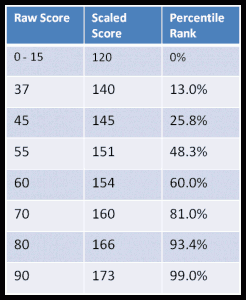Students starting their LSAT prep often have questions about what their scores actually mean, including:
- What is a good LSAT score?
- What do all the scores reported mean?
- How do I know what law schools think of my score?
Your LSAT score is made up of 3 components sent to you on your score report.
Raw LSAT Score
Raw LSAT score is simply the number of correct responses across the 4 scored sections, added up. Generally there are 99-101 questions on any particular LSAT, so this number is very close to your percentage of right answers.
Scaled LSAT Score
Scaled scores are on a band from 120-180. When people refer to your LSAT score, this is the number they are talking about. The LSAT applies a formula that differs slightly on different test forms to convert raw scores to scaled scores. (When you hear LSAT nerds talk about “the curve,” this conversion is what they mean.)
LSAT Percentile Score
Your percentile is the percent of test-takers that scored lower than you on that particular form.
What do LSAT Scores Mean?
Here is an example scoring scale; as mentioned this differs from test to test, but only slightly. If you got 55 questions right, your score would be 151, and 48% of students would have scored lower than you.

151 is generally the average score. It’s important to note that the LSAT is scored on a standard bell curve. Most students will score between 140 and 160, each a standard deviation from the mean of 151. Note that while many students start with a goal of a 170+ score, only very few students can accomplish that goal in a given year.
 How do School Interpret My LSAT Score?
How do School Interpret My LSAT Score?
Here’s a list of Chicago-area law schools. All of this data is available from the Law School Admissions Council and on the websites of particular schools, so do some research on the schools you are targeting.
 Let’s take the University of Chicago, a top-ranked school, as an example. For this year, the 75% LSAT was 173. This means that 75% of students scored 173 or lower (and 25% scored above 173). Similarly, the 25% LSAT is 169, meaning that 25% scored 169 or below. Therefore, the middle 50% of their class was between 173 and 169. To be competitive atChicago, you would want to have an LSAT in that range. Do note that 25% of their class had below a 169, but these students likely had a combination of near-perfect GPAs and very outstanding soft factors.
Let’s take the University of Chicago, a top-ranked school, as an example. For this year, the 75% LSAT was 173. This means that 75% of students scored 173 or lower (and 25% scored above 173). Similarly, the 25% LSAT is 169, meaning that 25% scored 169 or below. Therefore, the middle 50% of their class was between 173 and 169. To be competitive atChicago, you would want to have an LSAT in that range. Do note that 25% of their class had below a 169, but these students likely had a combination of near-perfect GPAs and very outstanding soft factors.
GPA numbers work in a similar way; the middle 50% of Chicago’s admitted class was between 3.84 and 3.63.
One note on GPA. You’ll often hear GPA discussed as “UGPA,” with the U standing for undergraduate. The LSAC determines this number, including your grades from all institutions you attended. LSAC also weights the GPA slightly (though it’s hard to say exactly how). Your official UGPA, then, will often be slightly different from that reported by your bachelors-granting institution.
Graduate GPA is not taken into account in determining this number. However, law school admissions committees will certainly examine your graduate school performance. Excellent marks in a MA program are likely to at least somewhat balance lower grades in undergrad.
Hopefully that gives you a good idea of what scores mean. The best place to start is to take a practice exam and see where your score falls related to your goals. For a link to a free practice test, email us at lsat@nextsteptestprep.com with “Practice Test” in the subject line and your name and year in school in the body.
Next Step Test Preparation provides complete courses of one-on-one tutoring with an LSAT expert for about the price of a crowded lecture-style prep course. Email us or call 888-530-NEXT (6398) for a complimentary consultation.



